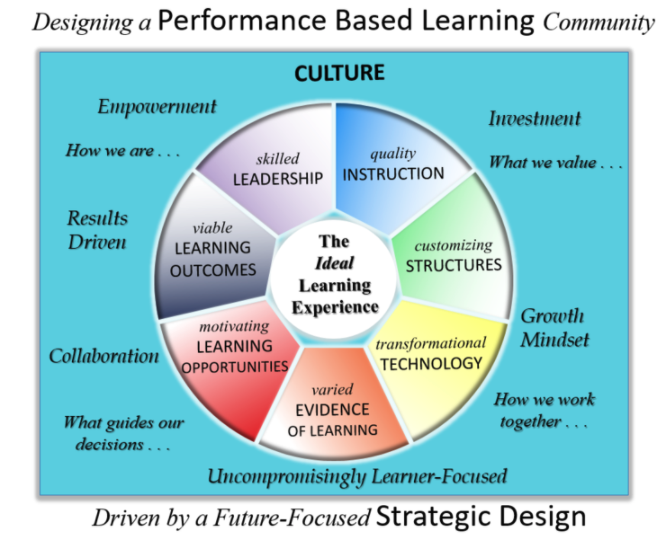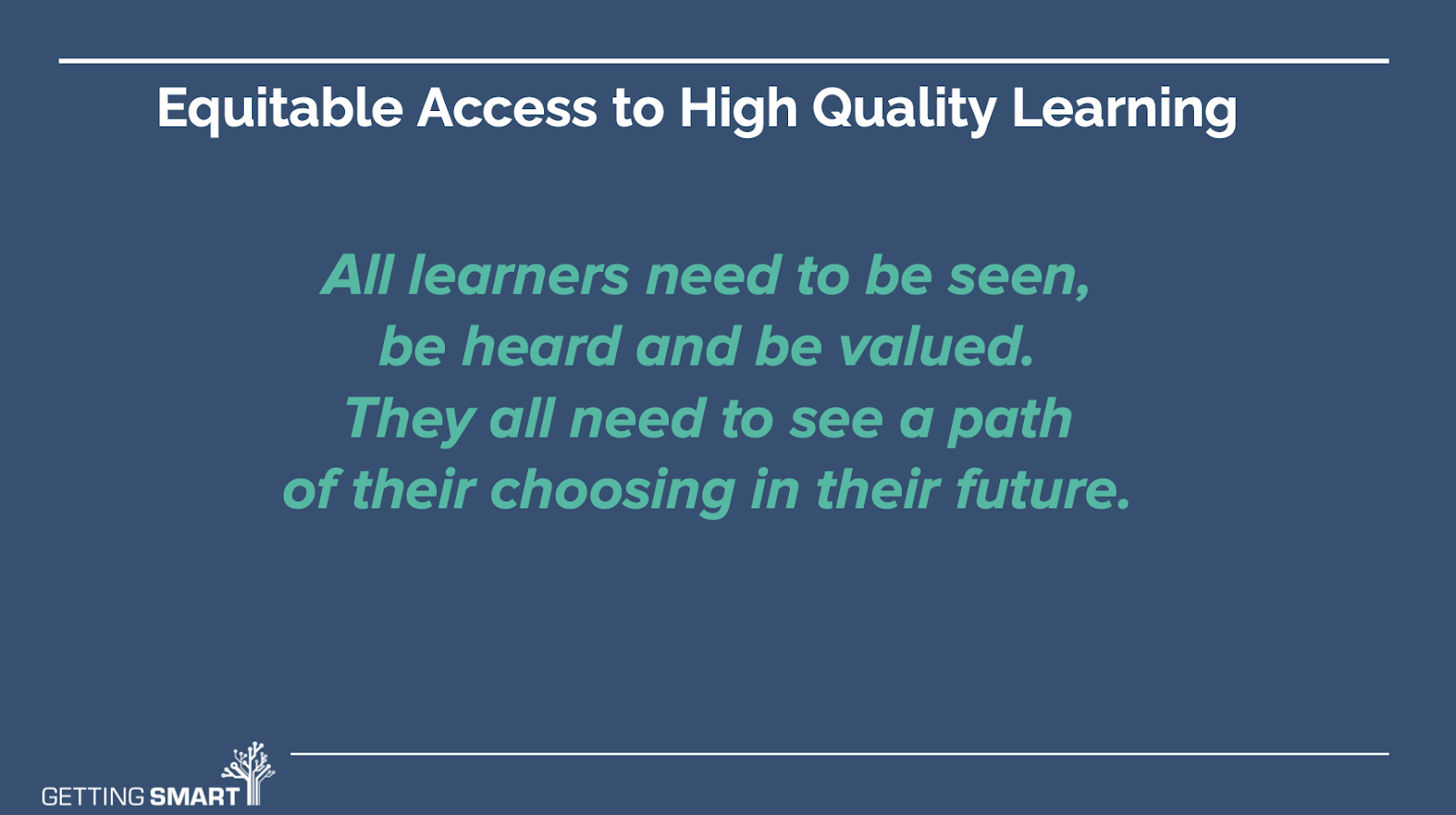CBE: Getting Started with Learner-Centered Practices with an Equity Lens
Key Points
-
We were excited to co-lead a session with Claudette Trujillo and Cinnamon Scheufele, focused on transformation approaches and learner-centered strategies rooted in equity and learning innovations.
-
All learners need to be seen, be heard and be valued. They all need to see a path of their choosing in their future.

Aurora 2021 was a chance for competency-based practitioners and innovators to come together to share updates and new thinking. We were excited to co-lead a session with Claudette Trujillo and Cinnamon Scheufele, focused on transformation approaches and learner-centered strategies rooted in equity and learning innovations.
These are not new topics, but they remain major challenges for many new entrants to the competency-based education (CBE) landscape and are crucial for ensuring that new CBE models reach the full promise of more powerful and more equitable learning for all students.
Often we might start with a shared vision. We haven’t given people time to catch up to the thinking around that and we haven’t made sure everyone’s at the table…that vision is not truly shared, it is just shared out.
Rebecca Midles
There are a number of different approaches to CBE transformation that are worth considering, and the most effective will largely depend on the context and nature of who is making the change (e.g., whether it is a district/system, individual school(s) within a district that is supportive of their efforts, or a magnet/charter school).

A District Perspective on Transformation
Cinnamon Scheufele has worked in Lindsay Unified School District (LUSD) for 28 years. She started teaching in Lindsay and later became a reading specialist in both English and Spanish. She has held the roles as Learning Facilitator (teacher), Director of Preschools, Principal and now serves as the Executive Director of Curriculum and Instruction.

She shared the story of LUSD and how their vision and strategic design began (list sources) and continues the work with the visual you see today of the ideal learning experience. Through their core values, beliefs and guiding principles, and the vision for what they want for their learners, LUSD continues to work toward the full realization of their Strategic Design.
If you have ever visited this district, then you have seen the unified approaches to organizing a system around learner needs and interests. In efforts to align their vision, they have SEL focus areas, called lifelong learning spheres, that are vertically aligned PK to graduate outcomes with intentional support throughout their district. This district also opens their doors for 4-5 visits a year for guests to see this work in action. This is currently paused during the pandemic but they have plans to resume when appropriate for learners and staff to receive outside guests.
Resources shared:
- LUSD Strategic Design
- Instructional Look Fors
- Site Level Conditions
- Measuring What Works: TLA
- Insight Education Group
Supporting District Vision with School Vision
Claudette Trujillo is principal of Metropolitan Arts Academy, a public school within Westminster Public Schools in Colorado. She has been working in personalized learning for over 15 years as a teacher and school leader, and actively supports district measures. She shared her journey of co-designing and implementing a school vision within a district vision. Claudette’s “why” is centered around solving the challenge of inequitable access to rigorous learning experiences across disparate student groups and communities. 
As a principal and life-long progressive educator, she co-developed a vision that established the conditions for immediate and equitable access to a rigorous arts program that includes performance opportunities through arts-integrated, project-based learning in a competency-based learning model for PK-8 learners in the Westminster Public School district. She zeroed in on key aspects of processes such as stakeholder input that is responsive to the communities needs and vision, systemic alignment, an equity focus rooted in the community, and opportunities for planning for mobility or postsecondary transition. She described two other points of entry or guidance more generally for site-level leaders seeking to root competency-based learning that is learner-centered and equity driven: starting with strengths, and equity-focused instructional design.
Schools, districts, and educators seeking to begin this process may find starting with an assessment of strengths helpful as the process compels individuals or institutions to do a deep dive into their inventory of resources (staff, finances, etc.), inventory of personnel (talents, strengths, and weaknesses/gaps), and finally a focus on recruitment for needs and visionaries (i.e., individuals that match the organization’s theory of change, mission, and vision). Next, she underlined the importance of instructional design and how it must be equity-driven, a process that requires an equity and innovation-focused approach for hiring and staffing assignments. This is foundational because it is an ongoing process that reflects the fact that the work of equity is inexhaustible or inextinguishable.
Resources Shared:
Podcast with Claudette Trujillo about Implementing
Learning Environment: Classroom
At Crosstown High, in Memphis, Tennessee, educators want to be sure that they are working with all students across demographic groups and performance levels to ensure a school culture exists that is wholly inclusive and reflective of a student’s lived experiences and diverse cultures, so that all learners feel like they want to be there and that they are wanted there by all stakeholders.
At Crosstown, our culture is founded on a strong mission and value statement that have guided us toward meaningful, culturally relevant and responsive, engaging learning experiences; deep meaningful relationships; full participation as youth voice and choice; intentionally designed and use of space and time supported by technology; and the full commitment of the community to ensure the wellbeing and education of the whole learner inside and outside the classroom.
All learners need to be seen, be heard and be valued. They all need to see a path of their choosing in their future.
Rebecca Midles
Crosstown’s learning environment at the classroom level seeks to support students and fulfill two of its core values: diversity by design and a relationship-driven culture, through the implementation of a robust advising framework that is supported by curricula from Facing History and Ourselves (FHAO) and an internally curated social-emotional learning and academic advising framework that seeks to support the learner’s journey by providing the requisite skills and tools that support the development of life-long learning skills and dispositional development and actualization.
Learners are also supported and encouraged by learner-centric and created affinity groups that provide a space and opportunity for individuals and groups of like characteristics to come together to discuss their experiences and provide support for further development.
Resources Shared:
5 Ways to Include Student Voice
Commitment to Equity and Human Centered approaches
Often we might start with a shared vision but may come to the realization that we have not given people time to catch up to the thinking around the design of that vision and we have not made sure everyone’s at the table. When a vision is not truly shared, it is just shared out. As schools and districts consider getting started with competency-based education with learner-centered practices and an equity lens, many entry points exist at the district level, school level, or learning environment, classroom level.

But educators must be willing to commit to fully including and genuinely listening to and internalizing the learner voice, staffing characteristics and cohesion, and instructional design to ensure the establishment of equitable access to high-quality learning environments regardless of the learner’s history or social location.

Rebecca Midles





0 Comments
Leave a Comment
Your email address will not be published. All fields are required.